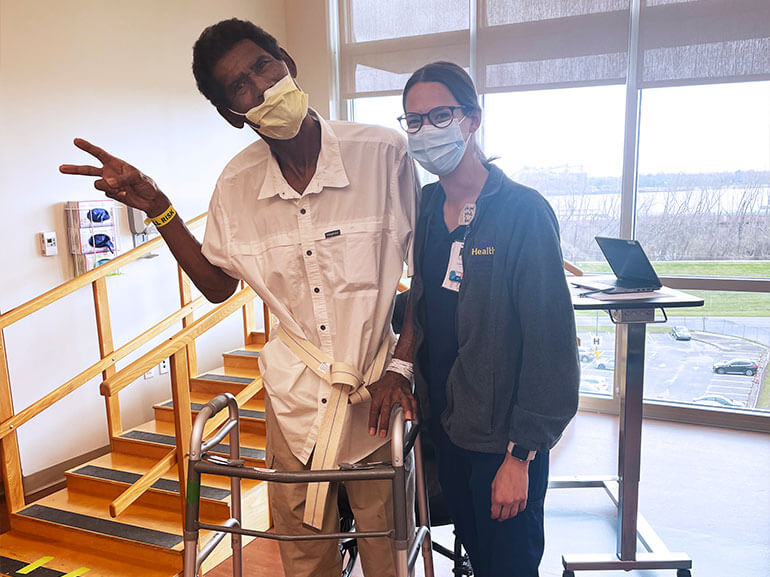Herman's Story

Herman Smiles is a 69-year old husband, father and grandfather from Violet, LA who worked as a handyman. In his spare time, he enjoys carpentry and repairing cars. One morning, he awoke to begin his day but found that he was unable to get out of bed. When he tried to stand, he fell on the floor. Fortunately, Herman was able to reach his phone and called his sister to let her know that something was wrong. She went directly to Herman’s house and rushed him to St. Bernard Hospital, where he was taken for an MRI.
Doctors determined Herman had suffered a stroke on the right side of his brain, which in turn affected the left side of his body and resulted in visuospatial neglect, a condition in which an individual lacks attention and awareness to one side of their body and environment. Because of this neglect, combined with lack of sensation and impaired control of his left side, Herman was unable to stand, walk without assistance or perform his personal care. The stroke had also impacted the left side of Herman’s face, causing weakness that made his face droop and made eating more difficult. After six days at St. Bernard Hospital, Herman was admitted to Ochsner Rehabilitation Hospital to begin his recovery.
Upon admission, Herman continued to struggle with the left side of his body and was also experiencing deficits in memory and problem solving. To address these challenges, his physician-led team of nurses, physical, occupational and speech therapists devised a plan to help Herman reach his goals and regain as much function and independence as possible.
Herman’s speech therapists provided education on stroke and safety awareness. In his therapy sessions, Herman worked to remember fall prevention safety strategies when transferring in and out of bed and his wheelchair.
When he arrived at Ochsner Rehabilitation Hospital, Herman was on a modified diet of soft foods due to difficulty with chewing and swallowing. Therapists guided him on practicing safe swallowing strategies to compensate for his facial weakness.
Speech therapists also worked with Herman to improve his memory and problem solving abilities using visual scanning activities to increase his attention to the left side of his body. Herman also practiced reading everyday materials, such as prescription labels and menus, to increase visual scanning skills. He also completed functional tasks like making phone calls and sorting items into piles in his left visual field to increase attention to that side.
In occupational therapy, Herman and his therapists focused on increasing his independence in completing his activities of daily living (ADLs), such as bathing, dressing and using the bathroom. At admission, Herman required significant assistance to complete these tasks. Therapists utilized a mirror to help Herman while getting dressed to assist with locating and recognizing items on his left side. While sitting and standing, he performed reaching activities using his left arm to improve his balance, coordination and control of his left side.
Because Herman was continuing to have difficulty using his left hand, his occupational therapy team had him practice opening and closing containers as well as grasping and releasing various items to improve sensation and functional use of his left side. They also added a weight around Herman’s wrist to improve the control and strength of his left arm. All of these interventions allowed Herman to improve his independence with basic daily tasks.
Simultaneously, Herman’s physical therapists provided sensory input to his left arm, leg and foot using vibration and massage. Initially, he was only making slight gains with walking, so the LiteGait, a body weight support system, was utilized to facilitate a more normal walking pattern without the risk of falling. Herman frequently had to be reminded to take big steps with his left foot and to place it appropriately in a straight line while walking. His therapists also applied a weight to his ankle to improve motor control and awareness to his left leg.
After 23 days at Ochsner Rehabilitation Hospital, Herman made excellent progress in his recovery. He was able to recall safety strategies with minimal reminders and improved his recall about his stroke education, including signs/symptoms and risk factors. Herman had also regained his ability to eat and drink normally by the time he was discharged as well as bathe, dress and use the bathroom without assistance. From a mobility standpoint, Herman advanced to propelling his wheelchair, walking over 150 feet with a walker, transferring in and out of his wheelchair or bed, and navigating a staircase with only someone standing by. Proudly, Herman was also able to briefly maintain his balance while standing without holding on to the walker.
When reflecting back on his rehabilitation journey, Herman shared that while his family called every day to check on him, he also viewed his therapists as family while at Ochsner Rehabilitation Hospital. He recalls how patient and kind the staff was and how he knew he would reach his goals with the help of his therapy team.
Herman had high praise for his time in rehab, saying: “Therapy can be fun and fulfilling. My therapists were patient and cheered me up. I went to the gym every day and looked forward to seeing my therapists. When I would come back to my room after a session, I would feel so good and encouraged.”
Through his journey, Herman learned that he can do anything if he focuses and puts his mind to it. He plans to continue his recovery at home with the help of his wife and home health therapy services.